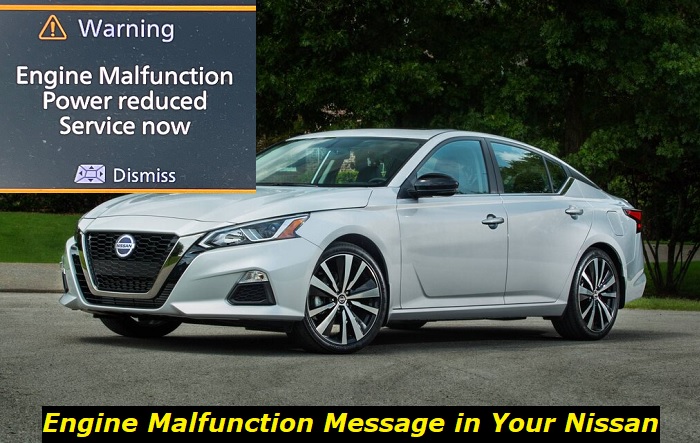Few things are more frightening than a sudden and unexpected error message while you're driving. One minute you could be cruising along, and the next minute you have a flashing error warning and you feel your engine's performance falling. If you look at your dashboard, you might see the words "Engine malfunction, power reduced, service now". What does this warning mean?
Engine malfunction, power reduced message highlights
- Common reasons:engine problems, electrical issues
- How to fix:read the codes, disconnect the battery for some time
- Possible consequences:power will be limited, engine may be damaged
- Priority level:High
- Can you drive?Carefully
- DIY repair:Impossible
- Repair price range:$150-$550

What is "Engine Malfunction, Power Reduced, Service Now"?
The reduced engine power warning comes up to let you know that the ECU has detected a problem in the engine. This problem is usually a sensor issue that won't allow the ECU to control the engine effectively. As a result, the ECU will limit the power the engine can produce, giving you enough engine power so that you're not stranded, while preventing further damage to the engine.
When this comes up you may notice a reduction of power in your engine. The ECU will leave you with enough engine power to get your car to a safe location for you to have it inspected or serviced. Usually, the engine power will be reduced such that you will only be able to reach speeds of 20 to 30 mph, also known as limp mode.
What Causes "Engine Malfunction, Power Reduced, Service Now"?
There are many different causes for this warning. This message acts as a sort of general warning, letting the driver know whenever there is any sort of problem with the engine that causes a power reduction. As a result, it is difficult to pinpoint the cause of this problem because it is so broad in scope.
Your car's engine control unit (ECU) monitors the condition of the engine using the data it receives from various sensors. If one of these sensors delivers irregular information, the ECU will detect it as a problem, causing it to bring up this error message.
1) Weak Battery
This is commonly reported by most Nissan drivers as the most common cause of the engine malfunction warning. The sensors in the engine start to malfunction and produce irregular readings if the voltage from the battery is too low. The ECU will detect these irregular readings as a sign of trouble, which can cause different warning lights and error messages to come up on the dashboard.
2) Sensor Malfunction
Sometimes the sensors in the engine fail to work. Many of the sensors in the engine play vital roles, and the engine cannot operate safely or efficiently without their input. The two sensors that are most commonly attached to this warning are the oxygen sensor and the throttle position sensor.
The throttle position sensor detects the position of the accelerator pedal, letting the ECU know the amount of fuel and air the engine should receive. The throttle position sensor is also involved in gear shifting in automatic vehicles.
The oxygen sensors, or O2 sensors, are another important sensor in your engine. The oxygen sensors measure the amount of oxygen in the vehicle's exhaust to make sure that the engine is supplied with the correct fuel-to-air ratio. If the oxygen sensors fail, the vehicle has no way of ensuring that the proper air-fuel mixture is being supplied. This could lead to a lean or rich fuel mixture, so the ECU reduces the engine power to prevent damage.
There are many different ways for sensors to fail, but the most common problems that engine sensors develop are wearing down due to age, becoming inoperable because of corrosion, or developing wiring or electrical faults.
3) ECU Fault
The reduced power state is triggered by the ECU. Normally the ECU initiates low power when it detects irregular readings from the engine sensors. However, the ECU can erroneously trigger reduced power if it develops any sort of software or electrical faults. Along with the reduced power condition, that ECU can also trigger several other dashboard warnings.
4) Faulty Throttle Body
Another common cause of the reduced power warning is a problem with the vehicle's throttle body. A faulty throttle body can result in the engine not getting the correct mixture of fuel and air. This reduces the engine's performance and can trigger an engine malfunction warning.
In some cases, a faulty throttle body might be physically damaged and needs to be replaced. Most times, however, the throttle body is simply dirty and stuck. A dirty throttle body is easily fixed by cleaning it with a wire brush and carburetor fluid
5) Faulty Wiring
Damaged wiring can cause problems in the communication between the ECU and any of the engine sensors. When this happens, the ECU might not be able to detect the feedback from the sensors, which causes it to bring up the engine malfunction warning.
This damage could be in the form of burned wires, worn or frayed wires, short circuits, or loose connectors.
6) Low Fluid Levels
Another common cause of this problem is low fluid levels. This could be low transmission fluid or low engine oil. These fluids act to lubricate and protect components of the engine and transmission. If their level is too low, it can lead to damage within the moving parts of the engine and transmission. As a result, low levels of these fluids can result in reduced power to protect the engine.
How to Fix "Engine Malfunction, Power Reduced, Service Now"?
To fix this problem and get your engine back in normal working order, you will need to find the underlying cause and address that. The easiest way to pinpoint the cause of this problem is to scan your car with an obd2 scanner. Once you've scanned the car, the diagnostic trouble codes you receive should indicate which components or system is malfunctioning.
If you don't have experience with automotive repair or with performing diagnostic scans on your car, then you should take your car to a certified mechanic. They will scan the car for you, identify the cause of the problem, and make the necessary repairs.
The exact steps you will take to fix this problem will depend on what you get from your OBD2 scan. Here are some of the steps you might need to carry out depending on which components are faulty.
- Top up the engine oil or transmission fluid
- Charge or replace a weak battery
- Clean or replace the oxygen sensor
- Replace the throttle position sensor
- Repair or replace faulty wiring
- Clean the throttle body
- Replace the faulty throttle body
- Replace the faulty ECU
Can I Still Drive When this Warning Comes Up?
Any error message coming up on your dashboard while you're driving is a worrying occurrence. When this particular message comes up, you might wonder if it is still safe for you to continue driving. You might be especially concerned when you notice the drastic reduction in power.
When this warning appears, it is best to just stop driving as soon as you can. reduced power is not effective for prolonged driving, especially on the highway. There is also a chance that you may cause damage to your car or engine if you continue driving longer than you need to. When your car goes into limp mode or reduced power mode, your engine provides you with enough power for you to safely get home or to an auto shop.
If the message appears while you're driving, you should slow down and pull over as soon as you can. Take your car to a safe location within driving distance, whether that's a parking lot, your home, or an auto shop.
Once there, contact a trusted mechanic, who will scan your car for diagnostic trouble codes to find out the cause of the problem.
Conclusion
When your Nissan displays "engine malfunction, power reduced, service now", it indicates that the car's ECU has detected a problem with the engine, and has reduced power to the engine to prevent further malfunctions or damage. The level of power reduction varies. Your car might be put completely into limp mode.
There are many different causes for this problem, so it can be difficult to diagnose. The fastest way to diagnose the problem is to make use of an OBD2 scanner. Depending on the codes you receive from the scanner, you'll be able to identify the component or system that is the origin of the problem.
In most cases, with Nissan vehicles, this problem is caused by a weak battery. Another common cause of this problem is an issue with the throttle body. Among the other causes of this problem are a faulty ECU, faulty sensors, faulty wiring, and low engine oil or transmission fluid levels.
About the authors
The CarAraC research team is composed of seasoned auto mechanics and automotive industry professionals, including individuals with advanced degrees and certifications in their field. Our team members boast prestigious credentials, reflecting their extensive knowledge and skills. These qualifications include: IMI: Institute of the Motor Industry, ASE-Certified Master Automobile Technicians; Coventry University, Graduate of MA in Automotive Journalism; Politecnico di Torino, Italy, MS Automotive Engineering; Ss. Cyril and Methodius University in Skopje, Mechanical University in Skopje; TOC Automotive College; DHA Suffa University, Department of Mechanical Engineering






Add comment